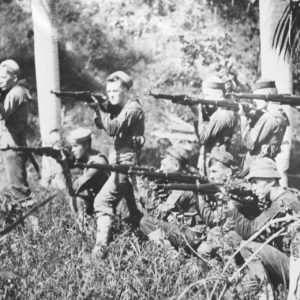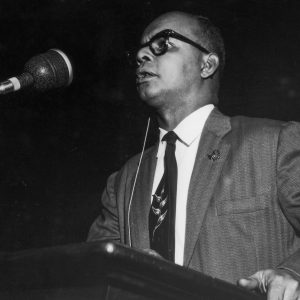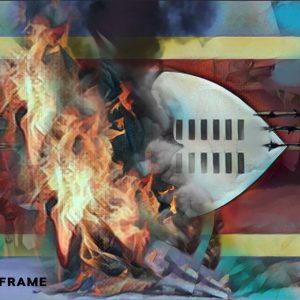Great men or the people: who makes history?
New books by Sudhir Hazareesingh and Jean Casimir offer fresh ways to make sense of the huge significance of the Haitian revolution and its afterlives.
Author:
16 September 2021

The Haitian revolution has, without doubt, been the one great event of world history. Although its importance has not been recognised by dominant historiography, and although its main protagonists have been largely effaced in textbooks, its achievements have continued to live among radical philosophers and in the popular imagination of the Global South.
It was the first world event to “shift the geography of reason” (to use Lewis Gordon’s famous expression) in the domain of political practice and not simply in that of theory. At the same time, intellectuals who understand the universal significance of this momentous event, or series of events, are still struggling to come to terms with its significance, not least because of what Aimé Césaire called – in his biography of Toussaint Louverture – the “colonial question”, with its attendant racism and exploitation that has yet to be satisfactorily resolved.
Rethinking early CLR James
In the introduction to his classic The Black Jacobins, CLR James claimed, “Great men make history, but only such history as it is possible for them to make. The freedom of achievement is limited by the necessities of their environment.”
Two comments should be particularly noted from this paraphrasing of Karl Marx’s 18th Brumaire. First, contrary to Marx’s original, it is for James great men – and not just men (people) – who made history in revolutionary Haiti, and that for these great men it was the influence of French revolutionary thought (Jacobinism) rather than African “communitarianism” that was the predominant political thinking behind the emancipatory struggles of the slaves (both men and women) of Saint Domingue later to become Hayti (Haiti). Second, the environmental constraints which James sees as necessarily limiting were sometimes inventively overcome, not least through total commitment to a collective desire for freedom by the masses of the mobilised plantation workers and the heroism of Black soldiers.
The last point is clearly demonstrated in Sudhir Hazareesingh’s biography of Toussaint Louverture. The military genius of leaders during these momentous struggles was often mitigated by a tendency to vacillate on their commitment to freedom and an equating of the latter idea with legal emancipation. In other words, social context and collective will at the time can be understood as dialectically and not simply as mechanically related, and the outcome as not necessarily supported by all Haitians.
Related article:
Finally, French Jacobinism had very little influence on the thinking of the enslaved people of African origin; it must not be forgotten that the overwhelming majority of the latter (around 60%) were born in Africa, were committed to an African collective way of life and had often learnt their military skills in Africa. It must also be recalled that not all slave owners were white; some freed Blacks and many “people of colour” were also slave owners; before 1793 all labour was slave labour.
One should not be too critical of James for, later on in his intellectual life, he insisted on the importance of the masses in the making of history and on the Hegelian dialectic as central to emancipatory thought. Nevertheless, the two books under review here enable us to question his early conceptions, which frequently dominate today, and to rethink these issues which are of value well beyond the specific case of the Haitian struggle for emancipation and most evidently for the Global South. These issues have still not been fully intellectually and practically exhausted.
In this year, the 230th anniversary of the ceremony of Bois Caïman in August 1791 – the gathering of slaves which inaugurated their struggle for freedom – we must ask more critical questions regarding the political thought and practice that made the extraordinary events which followed possible, as well as those concerning the limitations of the elite thought and practice which could ultimately get away with not only ignoring, but frequently suppressing, the slaves’ and their descendants’ universalistic egalitarian vision for humanity.
Beyond stereotypical understandings
It is no exaggeration to suggest that, in the Global South, those who show some awareness of the momentous events in Saint Domingue from 1791 and its transformation into independent Hayti in 1804 have adhered to a rather stereotypical understanding of those events, an understanding dominated by anti-colonial and anti-racist conceptions which, although fundamentally valid, have tended to produce what Frantz Fanon refers to as a “Manichean” dualism that simply provides a mirror image of the dominant colonial-racist one.
As one recent 21st century statement of support cited by Hazareesing put it, Louverture was seen “as the precursor of the global struggle for racial equality, and the founder of a tradition of revolutionary internationalism whose modern incarnations included Martin Luther King and Nelson Mandela”. The mythology surrounding such heroic figures has systematically transformed what were very difficult and complex political struggles involving different sectors of the popular masses into simplistic dualistic visions and Hollywoodian epics easily amenable to crude political understandings and forms of commercialisation to which progressives unwittingly frequently contribute.
Related article:
The two books reviewed here provide us, in different ways, with sophisticated accounts which debunk such mythologies. They both deserve much fuller treatment than is possible to give in a brief review.
The first, Hazareesingh’s Black Spartacus: The Epic Life of Toussaint Louverture, is probably the most detailed biography ever written of Louverture – the most well-known figure of the revolution – although there have been many of these. It is extremely well written and recommended to those who need an introductory history of the Saint Domingue revolution. At the same, it is limited – like all “history through biography” – by its superficial treatment of sociopolitical relations and popular struggles.
What we are presented with is an “epic life” whose brilliant military prowess and principled commitment to the abolition of slavery on the island led Louverture to overcome various invasions by foreign armies all intent on reintroducing the slave trade. Known as the “Black Spartacus” by many of his admirers, he combined his revolutionary commitment with French Republican egalitarian norms and undoubted charisma which inspired total commitment by his troops. Himself a freed ex-slave, and ex-slave owner, he, like most of the members of his class, was also committed to a somewhat reconfigured form of French Republican colonialism and to Masonic ideas of technical progress. He could not visualise, let alone comprehend, the people’s desire to rid themselves of the plantation system as such and not simply of chattel slavery. By 1802 he was thus easily captured by the now autocratic Napoleonic reconfiguration of the French Revolution and imprisoned high in the French Jura mountains where he died a martyr’s death the following year.
Writing from the people’s perspective
The popular opposition to wage-labour on the plantation system after slavery was legally abolished on the island in 1793 was the dominant political contradiction to acquire centre stage after independence in 1804. This issue is central to Jean Casimir’s book The Haitians, which is an important attempt to write a history of Haiti from the viewpoint of the masses of ex-slaves or cultivateurs (cultivators) as they became known.
These people were able to resist wage-labour – and to do so successfully – because they were opposed to the plantation system as such, which they saw as coercive and super-exploitative even after 1793. They fought for the setting up of family land parcels but the term “peasant” was not favoured by those in power, as they thought it referred too much to French relations that were not seen as appropriate within a colonial context.
Related article:
From at least his 1801 constitution, which outlawed slavery on the island, Louverture was coercing cultivators to remain on the plantations through various codes and decrees (including criminalising vagabonds and instituting various forms of pass controls) subsequently re-enforced by the self-declared kings and emperors who followed in his footsteps. Those ex-slaves who were freed by state largesse under colonialism frequently possessed a commitment to the French Republic which was not shared by those who had to fight for their freedom. Louverture was among the former.
Modes of resistance
Casimir provides a brilliant account of the formation of an independent nation of Haitians throughout the 19th century made up of “self-freed” people who were able to remain politically distinct from the state. From 1804 to 1915 (when the United States began to occupy the island for 20 years) the state never represented the sovereign people; the people remained their own sovereign and were able to structure their life on the basis of adapted African traditions: “Their experience led them to distance themselves as much as possible from [the nation-state], which had been the key to their oppression and exploitation, and to try to avoid its oversight over their communal life.”
People initially resisted through escaping into the mountains and forming independent communities of maroons as in other parts of the Caribbean, although they did not constitute separate and easily identifiable entities in plantation society. Cultivators were able to contribute to the destruction of the plantation system although the top commanders of the Black armies after independence had allocated themselves huge estates, and Jean-Jacques Dessalines in particular ruthlessly pursued and exterminated maroon communities.
Related article:
The Republican and post-independence states in Saint Domingue and Haiti did not transform the monarchical system of allocating land as a reward to favourites, and the cultivators were able to defend their plots because, with the collapse of the export market for tropical products, there was little possibility of capital accumulation in large-scale agriculture. Although these plots of land were small “the land would guarantee them the possibility of emancipating themselves from the yoke and the subordination of the daily wage labourer. The pursuit of independence depended on the strengthening of the links within the lakou and with neighbouring lakou.” Derived from West African traditions, the lakou was a central compound around which were located a number of households making up an extended family structure. According to one respondent, the lakou was “a well-defined geographical space. But the civil authorities have no authority over this space.”
Inventing new universes
Casimir shows that the subjective “transformation of captives into slaves was never complete” and consequently captives could invent a new universe for themselves “outside of modern colonial/racist and Eurocentric thought”. He cites a study that suggests that “capitalism was almost defeated by the 1804 revolution” and stresses that “the oligarchs who governed [the Haitian nation] during the 19th century didn’t have the political, economic or ideological resources to satisfy the sovereign people’s most basic needs”.
Thus it was left to the people themselves to satisfy their own needs and they did so by inventing new social relations and practices that were rooted in African traditions. Casimir calls this the “counter-plantation system”.
Related article:
The core cultural saying around which these practices revolved was tout moun se moun men ce pa memn moun (each person is a person even though they are not the same person). The meaning here is clear and this egalitarian system was maintained, not through coercion, but through norms that restricted class differentiation among family land-parcel owners.
In opposition to the commodity-producing plantation, this system was made up of new institutions that included “gender relations, family, the lakou, indivisible collective property, Voudou temples, rural markets, garden-towns, leisure, crafts, the arts … Taken together, all of these became specific tools for the class struggles of the Haitian peasantry. All the attempted attacks from the modern/colonial world represented by the oligarchs of the country shattered against these ramparts.” It was only with the American invasion in 1915 that these institutions were violently curtailed, and even then they were never completely eradicated.
New universes and conceptions
For Casimir, to refer to Haiti as a successful slave revolution or as the “first Black republic in the world” is to defer “to the premises of the ideologies of racist [empires] that invented the colonial Black”. He continues, “This vision of independence is based on the idea of the capitulation of the captive, compounded by his incapacity to contribute in any specific way to the history of humanity, since he identifies himself essentially as a freed slave who can congratulate himself for achieving the condition of a formerly or newly freed person. His exploit is limited to surpassing the status of those who … are slaves. All other possibilities for life … are set aside. The new universe carried by those who refuse slavery is destroyed, like everything that goes beyond the imagination of the hegemonic political formations.”
If we believe that, in some way, it is people who are the main motive force behind the making of history, we have to listen to what they have to say and to understand what they think; we also need to understand how to overcome the subjective differences between leaders and the masses.
Related article:
These two books help us to begin to understand not only the victory of the oppressed in Haiti, but also the international connections of the oligarchy (issued from those leaders) that assumed power after independence.
Haiti was forced to provide France with reparations for the loss of its slave economy after Jean Pierre Boyer, who was president of Haiti from 1818 to 1843, signed an indemnity treaty allowing Haiti to be recognised by the colonial powers of the time so as to be able to trade on the world market. The oligarchy’s subservience to colonial and neocolonial interests has arguably been the source of all the crises which the people of Haiti have been forced to confront, the latest of which is currently unfolding. As such the Haitian state can be seen as the precursor of the neocolonial state in Africa and elsewhere in the Global South.
In order for us to develop a clear understanding of how to begin to address the “colonial question”, we need to understand that all people are capable of thought beyond the confines of the subjectivities imposed by power, whether in the form of academic writings or state legislation, and to listen to the voice of the oppressed. As Zomba Boukman Dutty, the leading militant at the gathering, kept on exclaiming at the Bois Caïman ceremony: “Couté la libeté, li palé nan coeur nou tous! [Listen to freedom, it speaks in all our hearts!]”






